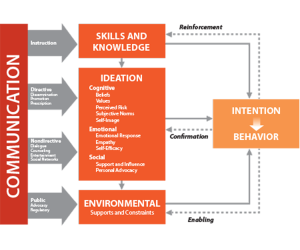HC3 Completes Series of Eight SBCC Research Primers

The Ideation model emphasizes how communication affects the intermediate outcomes that in turn determine behavior change.
HC3 has published four new research briefs that help guide social and behavior change communication (SBCC) practitioners when selecting research concepts, models and frameworks to consider when designing an SBCC program.
The Extended Parallel Processing Model (EPPM) is also widely known as Threat Management or Fear Management. It describes how rational considerations (efficacy beliefs) and emotional reactions (fear of a health threat) combine to determine behavioral decisions. EPPM is useful when a health issue poses a real or perceived threat to personal health, such as the current Ebola crisis.
Social (or Observational) Learning Theory stipulates that people can learn new behaviors by observing others. Earlier learning theories emphasized how people behave in response to environmental stimuli, such as physical rewards or punishment. The principles of social learning can be applied to almost any SBCC program that aims to influence social behaviors, particularly behaviors that are complex or involve interactions with other people.
Propensity Score Matching (PSM) is a statistical technique that allows researchers to more accurately measure SBCC program impact and to make a strong case for causal attribution. Using the PSM approach increases the accuracy of impact measurement because it controls for unaccounted factors that might bias a person to respond favorably to a communication program.
Ideation refers to how new ways of thinking (or new behaviors) are diffused through a community by means of communication and social interaction among individuals and groups. It should be used when trying to identify the psychosocial factors that predict behavior or when trying to causally attribute behavior change to communication interventions.
These four new briefs are part of a series that includes the following previously published research primers.








Leave a Reply
Want to join the discussion?Feel free to contribute!